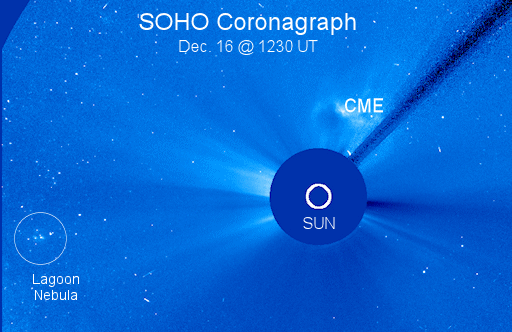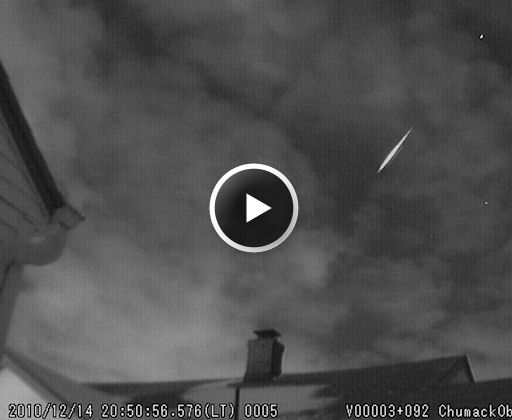These pictures are almost too hot to touch. Metallic photos of the sun make great Christmas gifts. | | |
GEO-QUIET: Although a solar wind stream is buffeting Earth's magnetic field, it's a gentle buffeting, and geomagnetic activity is low. Strong auroras are unlikely during the next 24 hours.
UPWARD BLAST: Magnetic filaments have been erupting on the sun with uncommon frequency these past two weeks. The latest event occurred earlier today around 0900 UT when a filament lifted off the stellar surface and propelled a coronal mass ejection into space. Coronagraphs onboard the Solar and Heliospheric Observatory (SOHO) recorded the expanding cloud:

Click to view a 6.7 MB gif movie
Earth was not in the line of fire; no planets were. The cloud is heading up and away from the plane of the solar system where it will dissipate with little effect a week or two hence. Like all the recent eruptions, this one missed our planet, but it is only a matter of time before a scattershot CME reaches Earth. When it does, you'll want to be alert for auroras.
GREAT GEMINIDS: On Dec. 13th and 14th, Earth passed through a stream of debris sputtering from mystery-rock 3200 Phaethon. The result was the annual Geminid meteor shower. At maximum, international observers counted more than 100 meteors per hour. "Even clouds could not stop the Geminids from putting on a great display," says John Chumack of Dayton, Ohio. "Just watch this movie."

More Geminid highlights from around the world may be found in the gallery:
UPDATED: 2010 Geminid Meteor Photo Gallery
[NASA: "Geminids Defy Explanation"] [meteor alerts]
November 2010 Aurora Gallery
[previous Novembers: 2009, 2008, 2007, 2006, 2004, 2003, 2002, 2001, 2000]
Potentially Hazardous Asteroids (
PHAs) are space rocks larger than approximately 100m that can come closer to Earth than 0.05 AU. None of the known PHAs is on a collision course with our planet, although astronomers are finding
new ones all the time.
On December 16, 2010 there were 1167 potentially hazardous asteroids.
Notes: LD means "Lunar Distance." 1 LD = 384,401 km, the distance between Earth and the Moon. 1 LD also equals 0.00256 AU. MAG is the visual magnitude of the asteroid on the date of closest approach. | | The official U.S. government space weather bureau |
| | The first place to look for information about sundogs, pillars, rainbows and related phenomena. |
| | Researchers call it a "Hubble for the sun." SDO is the most advanced solar observatory ever. |
| | 3D views of the sun from NASA's Solar and Terrestrial Relations Observatory |
| | Realtime and archival images of the Sun from SOHO. |
| | from the NOAA Space Environment Center |
| | the underlying science of space weather |

